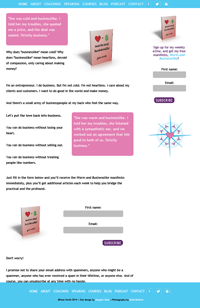This is a big year for us as a family- Kindergarten for our twin boys.
The first day was a rough start, and they almost conducted a sit down strike to avoid going the next day, but my wife and I listened empathetically and they both finally agreed to go the next morning and at least tell the teacher what had scared them/upset them. Whew! <wipes brow>.
We’re still considering home school because it so matches our values, and yet this Waldorf kindergarten is giving us a bit of a parenting break, and who knows, maybe it will work. We’ll see- it’s a bit of an experiment.
Which brings me to the topic of business. There’s a lot to be said for having a plan and following through. And there’s a lot to be said for experimenting. For a brand-new business, almost everything is an experiment, which is scary, because you need it to work!
And for a business that has been around, experimenting can also seem scary, because you don’t want to lose what you’ve got.
Yet experiment you must! We’re experimenting here, with ever-greening our offers, with the format of our weekly email and with being more personal with you.
One of the risks that happens when a business grows larger is a sense of disconnection from you. There’s a team here, it’s not just me, Mark. Who are you really reaching out to and getting help from? So we’re experimenting with breaking any barriers that might have come up by offering a Readiness Assessment, which means you get on the phone with one of us. For free.
If you’re wondering whether your business is ready to truly succeed, and wondering what it will take to get there, take us up on a Readiness Assessment. We’re starting out by only offering 20 of these for free because, well, it’s an experiment.
Check it out: Readiness Assessment
And now on to the topic for today:
Example of a heart-centered sales page
Selling something, workshop, individual sessions, a product, through your website means that you have to write(!) about your thang.
Copywriting is one of my specialities when I work with clients, because I’ve come to love this kind of writing. Strangely enough, I found myself, through a combination of bad scheduling and good opportunities, writing 3 sales pages in as many days.
That was an unusual creative fountain. Usually I spend one to two weeks writing a really solid sales page.
For others who haven’t had the experience I’ve had, I know writing these pages can feel really sticky. How can you write a sales page that is (a) effective at bringing in paying clients and (b) open-hearted, generous, and not pushy or manipulative?
There’s a fair amount to making it work, as the participants in our Foundations2: Expand Your Reach program are learning so wonderfully.
I have two examples of heart-centered sales pages that I think are worth looking at.
First: Pace Smith’s Warm and Business-like
 You might not think of this as a “sales” page because she’s not asking for money. But she is asking you to give her something, and in return she’s giving you something. Let’s not quibble, and just call it a “sales page.” Thanks for not quibbling. 🙂
You might not think of this as a “sales” page because she’s not asking for money. But she is asking you to give her something, and in return she’s giving you something. Let’s not quibble, and just call it a “sales page.” Thanks for not quibbling. 🙂
Reveal: Pace is a client of ours, actually she’s been a personal client of mine, and through Heart of Business she has transitioned from having a job to having a business that completely supports her and her partner, Kyeli. I think the world of both of them, and if you are drawn to every work with Pace, you will be in great hands.
Have a look at what she’s asking for and what she’s offering, then come back here and let me walk you through it.
Pace Smith’s Warm and Business-like
Great- were you drawn to sign up for her manifesto? It’s good for you to notice if you were or you weren’t, and why or why not.
It brings to mind an article I wrote, Marketing and Copyright Lessons from the Grateful Dead. The biggest point from that article that applies here is about being yourself, and the second biggest point is not fretting if you are similar to someone else.
It’s not unusual that someone close to me would also be talking about putting the love back into business, but, Pace is being totally herself.
Here’s another point not covered in the previous article. You only need to give enough information so that the person feels safe taking the action you’re asking them to take. If Pace had asked you to lay down one hundred in small bills to purchase her manifesto, she would have had to take a lot more effort explaining.
But she’s not. It’s a very low-risk investment, so she doesn’t have to work so hard. In fact, if she worked too hard, you might think something was wrong, what with her going overboard to convince you to sign up.
A third point is that the page is really heavy on values. She’s talking about her values in business, what she cares about.
This values thing is big, because it helps the reader decide whether she belongs to the same tribe as the writer. I was recently watching Oregon Public Broadcasting special on snow monkeys in central Japan. So beautiful! One phrase in that show stands out now, when a baby monkey was temporarily separated from the rest of the group: “For the snow monkeys, belonging means survival.”
Share your values in your biz. It helps people know that they belong to your tribe. (Click to tweet)
It’s coded into our DNA: to belong to a family unit, or a tribe, means survival. If you and I share values, then we’re both the same on the inside, and that means safety and survival. Without that safety, the reader won’t step in.
Don’t be abashed about sharing what you care about, from the heart, because that will help the reader resonate with you, or not. If they resonate, chances are they’ll step in. If they don’t, they wouldn’t have been good clients anyway, and better to find it out quickly.
I first really got this from a book by cognitive scientist George Lakoff. When I first implemented what I learned from the book, our subscription rate tripled overnight. Seriously.
So there’s 3 points to take away from this relatively short and simple page of Pace’s. First, somewhat paradoxically, be yourself and don’t worry if it’s similar to someone else. Second, give enough information so that the person reading feels safe enough to take the action you want. Third, include your values, which is perhaps part of the first point.
The Second Example?
It’s for a workshop I’m co-teaching in Edmonton, Alberta. I didn’t write the page, Tad Hargrave did, and I think he did an amazing job with it. It uses an approach, called “Mr./Ms. X” that is often seen as a manipulative approach, except the way Tad does it, it’s not. It’s fun.
Click: You can see the page here.
It’s too much to take on right now, so I’m going to discuss it more in depth next week.
Okay, over to you. Did you sign up for Pace’s Manifesto? Why or why not? And, what of the three points above can you apply to your own sales pages?
With love and appreciation,
Mark






